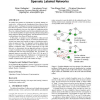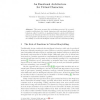2217 search results - page 162 / 444 » Learning from Collective Behavior |
KDD
2008
ACM
14 years 9 months ago
2008
ACM
We address the problem of classification in partially labeled networks (a.k.a. within-network classification) where observed class labels are sparse. Techniques for statistical re...
EDM
2008
13 years 10 months ago
2008
Students can use an educational system's help in unexpected r example, they may bypass abstract hints in search of a concrete solution. This behavior has traditionally been la...
EUSFLAT
2003
13 years 10 months ago
2003
A typical task in technical fault detection or medical diagnosis problems is to discriminate normal behavior from one or more types of abnormal behavior by means of different meas...
IJRR
2011
13 years 4 months ago
2011
Abstract People typically move and act under the constraints of an environment, making human behavior strongly place-dependent. Motion patterns, the places and the rates at which p...
STORYTELLING
2005
Springer
14 years 2 months ago
2005
Springer
This paper presents the mechanisms proposed by a generic cognitive architecture for virtual characters with emotional influenced behaviors, called cognitiva, to maintain behavior ...


